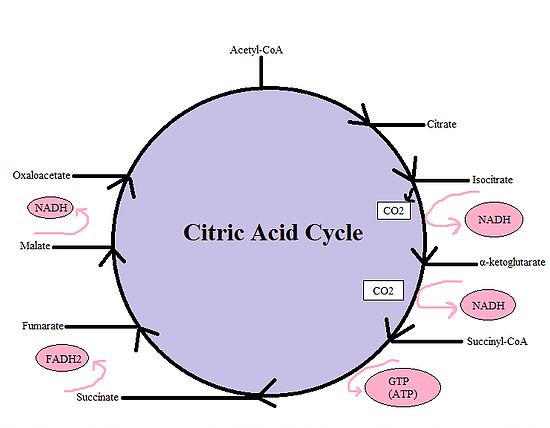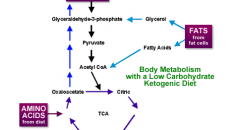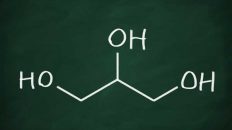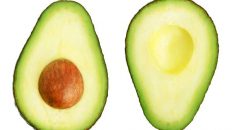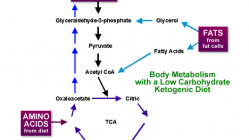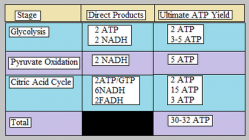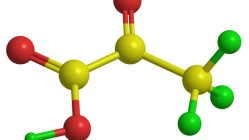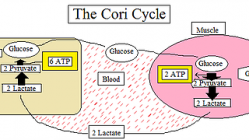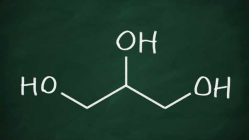Once glycolysis and pyruvate oxidation are completed the next step, when oxygen is present, is the Citric Acid Cycle (also known as the Krebs Cycle or Tricarboxylic Acid Cycle). The Citric Acid Cycle takes place in the matrix of eukaryotic cell’s mitochondria. This entire process is a closed loop meaning that it will use the molecules produced at the end in the beginning; it is comprised of eight steps.
Quick Overview of the Citric Acid Cycle:
From pyruvate oxidation, we are given acetyl CoA, this molecule is used in the first step of the Citric Acid Cycle. Acetyl CoA combines with 4-carbon molecule, known as oxaloacetate*, which forms a 6-carbon molecule known as citrate. Once citrate is formed, two carbons break off as CO2. This breaking creates one molecule of NADH**. After NADH is created, the remaining 4 carbons undergo other reactions that create either ATP (or GTP), reduce FAD to FADH2, and/or creating another molecule of NADH. From this, we can determine that one cycle of the Citric Acid Cycle creates three NADH molecules, one FADH2 molecule, one ATP or GTP*** molecule, and releases two CO2 molecules (*this is from only one turn, the Citric Acid Cycle turns twice thus for every glucose molecule that enters therefore from one glucose molecule we create six NADH molecules, two FADH2 molecules, two ATP or GTP molecules, and release four CO2 molecules.
*Oxaloacetate comes from breaking down citric acid
**NADH is the reduced form of NAD in electron transport reactions
***GTP and ATP are similar except for very minor differences between the two; GTP is more often used as a signaling molecule than an energy carrier like ATP (although GTP can be used as an energy carrier)
Further Examination of the Citric Acid Cycle:
1. The first step of the Citric Acid Cycle is the joining of Acetyl CoA with oxaloacetate which creates citrate
2. The second step of the Citric Acid Cycle is the conversion of citrate into its isomer isocitrate (*remember, an isomer is a molecule with the same combination of atoms but have a different arrangement).
3. The third step of Citric Acid Cycle is the removal of a molecule from isocitrate; this creates a 5-carbon molecule called α-ketoglutarate. It is in this step where NAD is reduced to create NADH
*The enzyme present here is isocitrate dehydrogenase
4. The fourth step of the Citric Acid Cycle is the oxidation of α-ketoglutarate. This remaining 4-carbon molecule combines with Coenzyme A which creates succinyl CoA
*The enzyme present here is α-ketoglutarate dehydrogenase
5. The fifth step of the Citric Acid Cycle is the replacement of CoA of the succinyl CoA by a phosphate group (this is transferred to ADP to create ATP) which creates the molecule known as succinate
*Here we can also determine that sometimes GDP is used instead of ADP which creates GTP
6. In this sixth step of the Citric Acid Cycle succinate is oxidized to create a molecule known as fumarate; with this reaction FAD is turned into FADH2 by the transfer of two hydrogen atoms
7. In the seventh step of the Citric Acid Cycle H2O is added to fumarate which creates a molecule known as malate
8. In the eighth and last step of the Citric Acid Cycle, malate is oxidized which creates oxaloacetate
*In this step an additional molecule of NAD is reduced to NADH
